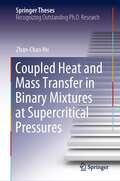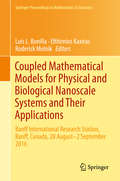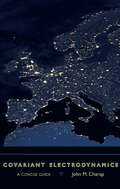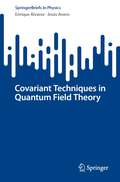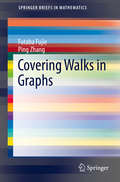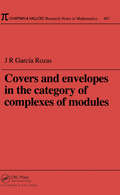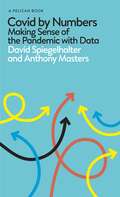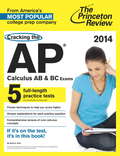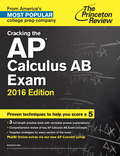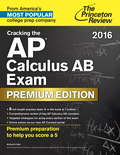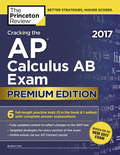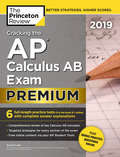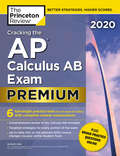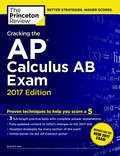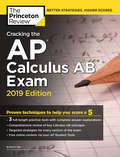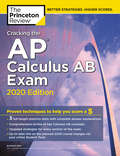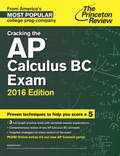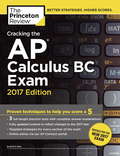- Table View
- List View
Coupled Heat and Mass Transfer in Binary Mixtures at Supercritical Pressures (Springer Theses)
by Zhan-Chao HuSupercritical pressure fluids have been exploited in many engineering fields, where binary mixtures are frequently encountered. This book focuses on the coupled heat and mass transfer in them, where the coupling comes from cross-diffusion effects (i.e., Soret and Dufour effects) and temperature-dependent boundary reactions. Under this configuration, three main topics are discussed: relaxation and diffusion problems, hydrodynamic stability, and convective heat and mass transfer. This book reports a series of new phenomena, novel mechanisms, and an innovative engineering design in hydrodynamics and transport phenomena of binary mixtures at supercritical pressures. This book covers not only current research progress but also basic knowledge and background. It is very friendly to readers new to this field, especially graduate students without a deep theoretical background.
Coupled Mathematical Models for Physical and Biological Nanoscale Systems and Their Applications: Banff International Research Station, Banff, Canada, 28 August - 2 September 2016 (Springer Proceedings in Mathematics & Statistics #232)
by Roderick Melnik Luis L. Bonilla Efthimios KaxirasThis volume gathers selected contributions from the participants of the Banff International Research Station (BIRS) workshop Coupled Mathematical Models for Physical and Biological Nanoscale Systems and their Applications, who explore various aspects of the analysis, modeling and applications of nanoscale systems, with a particular focus on low dimensional nanostructures and coupled mathematical models for their description. Due to the vastness, novelty and complexity of the interfaces between mathematical modeling and nanoscience and nanotechnology, many important areas in these disciplines remain largely unexplored. In their efforts to move forward, multidisciplinary research communities have come to a clear understanding that, along with experimental techniques, mathematical modeling and analysis have become crucial to the study, development and application of systems at the nanoscale. The conference, held at BIRS in autumn 2016, brought together experts from three different communities working in fields where coupled mathematical models for nanoscale and biosystems are especially relevant: mathematicians, physicists (both theorists and experimentalists), and computational scientists, including those dealing with biological nanostructures. Its objectives: summarize the state-of-the-art; identify and prioritize critical problems of major importance that require solutions; analyze existing methodologies; and explore promising approaches to addressing the challenges identified. The contributions offer up-to-date introductions to a range of topics in nano and biosystems, identify important challenges, assess current methodologies and explore promising approaches. As such, this book will benefit researchers in applied mathematics, as well as physicists and biologists interested in coupled mathematical models and their analysis for physical and biological nanoscale systems that concern applications in biotechnology and medicine, quantum information processing and optoelectronics.
Covariance and Gauge Invariance in Continuum Physics: Application to Mechanics, Gravitation, and Electromagnetism (Progress in Mathematical Physics #73)
by Lalaonirina R. RakotomananaThis book presents a Lagrangian approach model to formulate various fields of continuum physics, ranging from gradient continuum elasticity to relativistic gravito-electromagnetism. It extends the classical theories based on Riemann geometry to Riemann-Cartan geometry, and then describes non-homogeneous continuum and spacetime with torsion in Einstein-Cartan relativistic gravitation. It investigates two aspects of invariance of the Lagrangian: covariance of formulation following the method of Lovelock and Rund, and gauge invariance where the active diffeomorphism invariance is considered by using local Poincaré gauge theory according to the Utiyama method. Further, it develops various extensions of strain gradient continuum elasticity, relativistic gravitation and electromagnetism when the torsion field of the Riemann-Cartan continuum is not equal to zero. Lastly, it derives heterogeneous wave propagation equations within twisted and curved manifolds and proposes a relation between electromagnetic potential and torsion tensor.
Covariant Electrodynamics: A Concise Guide
by John M. CharapA notoriously difficult subject, covariant electrodynamics is nonetheless vital for understanding relativistic field theory. John M. Charap’s classroom-tested introduction to the mathematical foundations of the topic presents the material in an approachable manner.Charap begins with a historical overview of electrodynamics and a discussion of the preliminary mathematics one needs in order to grasp the advanced and abstract concepts underlying the theory. He walks the reader through Maxwell’s four equations, explaining how they were developed and demonstrating how they are applied. From there, Charap moves through the other components of electrodynamics, such as Lorentz transformations, tensors, and charged particle behavior. At each point, he carefully works through the mathematics, applies the concepts to simple physical systems, and provides historical context that makes clear the connections among the theories and the mathematicians responsible for developing them. A concluding chapter reviews the history of electrodynamics and points the way for independent testing of the theory.Thorough, evenly paced, and intuitive, this friendly introduction to high-level covariant electrodynamics is a handy and helpful addition to any physicist’s toolkit.
Covariant Techniques in Quantum Field Theory (SpringerBriefs in Physics)
by Enrique Álvarez Jesús AneroThe purpose of this book is to illustrate some of the most important techniques which are helpful in combinatorial problems when computing quantum effects in covariant theories, like general relativity. In fact, most of the techniques find application also in broader contexts, such as low energy effective (chiral) Lagrangians or even in specific problems in condensed matter. Some of the topics covered are: the background field approach and the heat kernel ideas. The arguments are explained in some detail and the presentation is meant for young researchers and advanced students who are starting working in the field. As prerequisite the reader should have attended a course in quantum field theory including Feynman’s path integral. In the Appendix a nontrivial calculation of one-loop divergences in Einstein-Hilbert gravity is explained step-by-step.
Covering Walks in Graphs (SpringerBriefs in Mathematics)
by Ping Zhang Futaba FujieCovering Walks in Graphs is aimed at researchers and graduate students in the graph theory community and provides a comprehensive treatment on measures of two well studied graphical properties, namely Hamiltonicity and traversability in graphs. This text looks into the famous Kӧnigsberg Bridge Problem, the Chinese Postman Problem, the Icosian Game and the Traveling Salesman Problem as well as well-known mathematicians who were involved in these problems. The concepts of different spanning walks with examples and present classical results on Hamiltonian numbers and upper Hamiltonian numbers of graphs are described; in some cases, the authors provide proofs of these results to illustrate the beauty and complexity of this area of research. Two new concepts of traceable numbers of graphs and traceable numbers of vertices of a graph which were inspired by and closely related to Hamiltonian numbers are introduced. Results are illustrated on these two concepts and the relationship between traceable concepts and Hamiltonian concepts are examined. Describes several variations of traceable numbers, which provide new frame works for several well-known Hamiltonian concepts and produce interesting new results.
Covers and Envelopes in the Category of Complexes of Modules
by J.R. Garcia RozasOver the last few years, the study of complexes has become increasingly important. To date, however, most of the research is scattered throughout the literature or available only as lecture notes. Covers and Envelopes in the Category of Complexes of Modules collects these scattered notes and results into a single, concise volume that provides an account of recent developments in the theory and presents several new and important ideas.The author introduces the theory of complexes of modules using only elementary tools-making the field more accessible to non-specialists. He focuses the study on envelopes and covers in this category with respect to some well established and important classes of complexes. He places particular emphasis on DG-injective and DG-projective complexes and flat and DG-flat covers.Other topics covered include Zorn's Lemma for categories, preserving and reflecting covers by functors, orthogonality in the category of complexes, Gorenstein injective and projective complexes, and pure sequences of complexes.Along with its value as a collection of recent work in the field, Covers and Envelopes in the Category of Complexes of Modules presents powerful new ideas that will undoubtedly advance homological methods. Mathematicians-especially researchers in module theory and homological algebra-will welcome this volume as a reference guide and for its new and important results.
Covid By Numbers: Making Sense of the Pandemic with Data (Pelican Books)
by David Spiegelhalter Anthony Masters'I couldn't imagine a better guidebook for making sense of a tragic and momentous time in our lives. Covid by Numbers is comprehensive yet concise, impeccably clear and always humane' Tim HarfordHow many people have died because of COVID-19? Which countries have been hit hardest by the virus? What are the benefits and harms of different vaccines? How does COVID-19 compare to the Spanish flu? How have the lockdown measures affected the economy, mental health and crime?This year we have been bombarded by statistics - seven day rolling averages, rates of infection, excess deaths. Never have numbers been more central to our national conversation, and never has it been more important that we think about them clearly. In the media and in their Observer column, Professor Sir David Spiegelhalter and RSS Statistical Ambassador Anthony Masters have interpreted these statistics, offering a vital public service by giving us the tools we need to make sense of the virus for ourselves and holding the government to account.In Covid by Numbers, they crunch the data on a year like no other, exposing the leading misconceptions about the virus and the vaccine, and answering our essential questions. This timely, concise and approachable book offers a rare depth of insight into one of the greatest upheavals in history, and a trustworthy guide to these most uncertain of times.
Cox Rings
by Ivan Arzhantsev Ulrich Derenthal Jürgen Hausen Antonio LafaceCox rings are significant global invariants of algebraic varieties, naturally generalizing homogeneous coordinate rings of projective spaces. This book provides a largely self-contained introduction to Cox rings, with a particular focus on concrete aspects of the theory. Besides the rigorous presentation of the basic concepts, other central topics include the case of finitely generated Cox rings and its relation to toric geometry; various classes of varieties with group actions; the surface case; and applications in arithmetic problems, in particular Manin's conjecture. The introductory chapters require only basic knowledge in algebraic geometry. The more advanced chapters also touch on algebraic groups, surface theory, and arithmetic geometry. Each chapter ends with exercises and problems. These comprise mini-tutorials and examples complementing the text, guided exercises for topics not discussed in the text, and, finally, several open problems of varying difficulty.
Coyotes All Around
by Stuart J. MurphyClever Coyote thinks it's time for lunch -- and also time to show her friends how, with some simple rounding, she can add up numbers in her head. If only she were as good at hunting as she is at math!
Cracking Mathematics: You, this book and 4,000 years of theories
by Colin BeveridgeThis comprehensive guide covers the history and development of mathematics, from the Ancient Egyptians and Pythagoreans to key figures such as Galileo, Dodgson, Babbage and Lovelace through to contemporary work of the 21st century. It tells of the remarkable stories that have shaped mathematics and also features sections on how maths can be used to solve the mysteries of the universe, what the Prisoner's Dilemma is as well as Fermat's Last Theorem amongst many more.Accessible, well-informed and fully-illustrated, this is a book that shows perfectly just how varied and fascinating mathematics is as a subject.
Cracking Mathematics: You, this book and 4,000 years of theories
by Colin BeveridgeThis comprehensive guide covers the history and development of mathematics, from the Ancient Egyptians and Pythagoreans to key figures such as Galileo, Dodgson, Babbage and Lovelace through to contemporary work of the 21st century. It tells of the remarkable stories that have shaped mathematics and also features sections on how maths can be used to solve the mysteries of the universe, what the Prisoner's Dilemma is as well as Fermat's Last Theorem amongst many more. Accessible, well-informed and fully-illustrated, this is a book that shows perfectly just how varied and fascinating mathematics is as a subject.
Cracking the AP Calculus AB & BC Exams, 2013 Edition
by Princeton ReviewIf you need to know it, it's in this book. Cracking the AP Calculus AB and BC Exams, 2013 Edition has been optimized for e-reader viewing with cross-linked questions, answers, and explanations, and includes: * 5 full-length practice tests with detailed explanations (3 for AB and 2 for BC) * A comprehensive review of all topics, from derivatives to integrals to logarithmic functions * Over 400 practice questions to hone your skills, with detailed answers and explanations to show you exactly how to improve * A cheat sheet of key formulas * Updated strategies which reflect the AP test scoring change
Cracking the AP Calculus AB Exam 2015 Edition
by Princeton ReviewEVERYTHING YOU NEED TO SCORE A PERFECT 5. Equip yourself to ace the AP Calculus AB Exam with The Princeton Review's comprehensive study guide--including thorough content reviews, targeted strategies for every question type, and 3 full-length practice tests with complete answer explanations.We don't have to tell you how tough AP Calculus is--or how important a stellar score on the AP exam can be to your chances of getting into a top college of your choice. Written by Princeton Review experts who know their way around Calc AB, Cracking the AP Calculus AB Exam will give you:Techniques That Actually Work.* Tried-and-true strategies to avoid traps and beat the test* Tips for pacing yourself and guessing logically* Essential tactics to help you work smarter, not harderEverything You Need to Know for a High Score.* Comprehensive content review for all test topics* Up-to-date information on the 2015 AP Calculus AB Exam* Engaging activities to help you critically assess your progressPractice Your Way to Perfection.* 3 full-length practice tests with detailed answer explanations* Practice drills throughout each content review chapter* Handy reference guide of key calculus formulas This eBook edition has been formatted for on-screen viewing with cross-linked questions, answers, and explanations.
Cracking the AP Calculus AB Exam 2016, Premium Edition
by Princeton ReviewPREMIUM PRACTICE FOR A PERFECT 5! Equip yourself to ace the AP Calculus AB Exam with this Premium version of The Princeton Review's comprehensive study guide. In addition to thorough content reviews, targeted test strategies, and access to AP Connect extras via our online portal, this title includes 6 full-length practice tests (the highest number in the market!) with complete answer explanations!This eBook edition has been specially formatted for on-screen viewing with cross-linked questions, answers, and explanations.Everything You Need to Know to Help Achieve a High Score.* Comprehensive content review for all test topics* Up-to-date information on the 2016 AP Calculus AB Exam* Engaging activities to help you critically assess your progress* Access to AP Connect, our online portal for helpful pre-college information and exam updatesPremium Practice to Help Achieve Excellence.* 6 full-length practice tests with detailed answer explanations* Practice drills throughout each content review chapter* Handy reference guide of key calculus formulasTechniques That Actually Work.* Tried-and-true strategies to help you avoid traps and beat the test* Tips for pacing yourself and guessing logically* Essential tactics to help you work smarter, not harderWe don't have to tell you how tough AP Calculus can be to master--but with Cracking the AP Calculus AB Exam 2016, Premium Edition, you'll be armed to take on the test and achieve your highest possible score!
Cracking the AP Calculus AB Exam 2017, Premium Edition
by Princeton ReviewPREMIUM PRACTICE FOR A PERFECT 5! Equip yourself to ace the NEW 2017 AP Calculus AB Exam with this Premium version of The Princeton Review's comprehensive study guide, fully updated to reflect changes to the 2017 test.In addition to all the great material in our classic Cracking the AP Calculus AB Exam guide--which includes thorough content reviews, targeted test strategies, and access to AP Connect extras via our online portal--this edition includes extra exams, for a total of 6 full-length practice tests with complete answer explanations!This book is an excellent value, providing more practice tests than any other major offering currently on the market.Everything You Need to Know to Help Achieve a High Score.* Up-to-date information on the new 2017 AP Calculus AB Exam* Comprehensive content review for all test topics* Engaging activities to help you critically assess your progress* Access to AP Connect, our online portal for late-breaking news, exam updates, and morePremium Practice to Help Achieve Excellence.* 5 full-length practice tests in the book with detailed answer explanations* 1 additional full-length practice test online with detailed answer explanations* End-of-chapter and comprehensive unit drills* Handy reference guide of key calculus formulasTechniques That Actually Work.* Tried-and-true strategies to help you avoid traps and beat the test* Tips for pacing yourself and guessing logically* Essential tactics to help you work smarter, not harderThis eBook edition has been optimized for on-screen viewing with cross-linked questions, answers, and explanations.
Cracking the AP Calculus AB Exam 2018, Premium Edition
by Princeton ReviewPREMIUM PRACTICE FOR A PERFECT 5! Ace the AP Calculus AB Exam with this Premium version of The Princeton Review's comprehensive study guide.In addition to all the great material in our classic Cracking the AP Calculus AB Exam guide—which includes thorough content reviews, targeted test strategies, and access to online extras via our AP Connect portal—this edition includes extra exams, for a total of 6 full-length practice tests with complete answer explanations!This book provides the most practice at the best price (more tests than any other major offering currently on the market, at a price that's 20% less than the nearest competitor).Everything You Need to Know to Help Achieve a High Score.• Comprehensive content review for all test topics• Up-to-date information on the 2018 AP Calculus AB Exam• Subjects organized into manageable units• Access to AP Connect, our online portal for helpful pre-college information and exam updatesPremium Practice to Help Achieve Excellence.• 5 full-length practice tests in the book with detailed answer explanations• 1 additional full-length practice test online with detailed answer explanations• Comprehensive drills at the end of each chapter and unit• Handy guide to key calculus formulas, plus bonus tips online for optimizing your TI-84 calculatorTechniques That Actually Work.• Tried-and-true strategies to help you avoid traps and beat the test• Tips for pacing yourself and guessing logically• Essential tactics to help you work smarter, not harderThis eBook edition is optimized for on-screen learning with cross-linked questions, answers, and explanations.
Cracking the AP Calculus AB Exam 2019, Premium Edition: 6 Practice Tests + Complete Content Review (College Test Preparation)
by Princeton ReviewPREMIUM PRACTICE FOR A PERFECT 5! Ace the AP Calculus AB Exam with this Premium version of The Princeton Review's comprehensive study guide. Includes 6 full-length practice tests with complete explanations, plus thorough content reviews, targeted test strategies, and access to online extras.This book provides the most practice at the best price—more tests than any other major offering currently on the market, at a price that's 20% less than the nearest competitor).Everything You Need to Know to Help Achieve a High Score.• Comprehensive content review for all test topics• Up-to-date information on the 2019 AP Calculus AB Exam• Subjects organized into manageable units• Access to online study plans, a handy list of key terms and concepts, helpful pre-college information, and morePremium Practice to Help Achieve Excellence.• 5 full-length practice tests in the book with detailed answer explanations• 1 additional full-length practice test online with detailed answer explanations• Comprehensive drills at the end of each chapter and unit• Handy reference guide of key calculus formulasTechniques That Actually Work.• Tried-and-true strategies to help you avoid traps and beat the test• Tips for pacing yourself and guessing logically• Essential tactics to help you work smarter, not harder
Cracking the AP Calculus AB Exam 2020, Premium Edition: 6 Practice Tests + Complete Content Review (College Test Preparation)
by The Princeton ReviewPREMIUM PRACTICE FOR A PERFECT 5! Ace the AP Calculus AB Exam with this Premium version of The Princeton Review's comprehensive study guide. Includes 6 full-length practice tests with complete explanations, plus thorough content reviews, targeted test strategies, and access to online extras.Everything You Need to Know to Help Achieve a High Score.• Comprehensive content review for all test topics• Up-to-date information on the planned 2020 course changes via your online Student Tools• Subjects organized into manageable units• Access to online drills, study plans, a handy list of key terms and concepts, helpful pre-college information, and morePremium Practice for AP Excellence.• 5 full-length practice tests in the book with detailed answer explanations• 1 additional full-length practice test online with detailed answer explanations• Practice drills at the end of each content review chapter• Helpful reference guide of key calculus formulas and comprehensive drill units availabe onlineTechniques That Actually Work.• Tried-and-true strategies to help you avoid traps and beat the test• Tips for pacing yourself and guessing logically• Essential tactics to help you work smarter, not harder
Cracking the AP Calculus AB Exam, 2017 Edition
by Princeton ReviewEVERYTHING YOU NEED TO SCORE A PERFECT 5 ON THE NEW 2017 EXAM!Equip yourself to ace the NEW AP Calculus AB Exam with The Princeton Review's comprehensive study guide--including thorough content reviews, targeted strategies for every question type, access to our AP Connect portal online, and 3 full-length practice tests with complete answer explanations. This eBook edition has been optimized for on-screen viewing with cross-linked questions, answers, and explanations.Everything You Need to Know to Help Achieve a High Score.* Up-to-date information on the new 2017 AP Calculus AB Exam * Comprehensive content review for all test topics * Engaging activities to help you critically assess your progress * Access to AP Connect, our online portal for late-breaking news, exam updates, and more Techniques That Actually Work. * Tried-and-true strategies to help you avoid traps and beat the test * Tips for pacing yourself and guessing logically * Essential tactics to help you work smarter, not harderPractice that Takes You to Excellence. * 3 full-length practice tests in the book with detailed answer explanations* End-of-chapter and comprehensive unit drills * Handy reference guide of key calculus formulas
Cracking the AP Calculus AB Exam, 2018 Edition: Proven Techniques to Help You Score a 5
by Princeton ReviewEVERYTHING YOU NEED TO SCORE A PERFECT 5. Ace the AP Calculus AB Exam with this comprehensive study guide—including 3 full-length practice tests, thorough content reviews, access to our AP Connect online portal, and targeted strategies for every question type.This eBook edition has been optimized for on-screen learning with cross-linked questions, answers, and explanations. Written by the experts at The Princeton Review, Cracking the AP Calculus AB Exam arms you to take on the test with:Techniques That Actually Work.• Tried-and-true strategies to help you avoid traps and beat the test• Tips for pacing yourself and guessing logically• Essential tactics to help you work smarter, not harderEverything You Need to Know to Help Achieve a High Score.• Comprehensive content review for all test topics• Up-to-date information on the 2018 AP Calculus AB Exam• Subjects organized into manageable units• Access to AP Connect, our online portal for helpful pre-college information and exam updatesPractice that Takes You to Excellence.• 3 full-length practice tests in the book with detailed answer explanations• Comprehensive drills at the end of each chapter and unit• Handy guide to key calculus formulas, plus bonus tips online for optimizing your TI-84 calculator
Cracking the AP Calculus AB Exam, 2019 Edition: Practice Tests & Proven Techniques to Help You Score a 5 (College Test Preparation)
by Princeton ReviewEVERYTHING YOU NEED TO SCORE A PERFECT 5. Ace the AP Calculus AB Exam with this comprehensive study guide—including 3 full-length practice tests, thorough content reviews, targeted strategies for every question type, and access to online extras.Techniques That Actually Work.• Tried-and-true strategies to help you avoid traps and beat the test• Tips for pacing yourself and guessing logically• Essential tactics to help you work smarter, not harderEverything You Need to Know to Help Achieve a High Score.• Comprehensive content review for all test topics• Up-to-date information on the 2019 AP Calculus AB Exam• Subjects organized into manageable units• Access to online study plans, a handy list of key terms and concepts, helpful pre-college information, and morePractice that Takes You to Excellence.• 3 full-length practice tests in the book with detailed answer explanations• Comprehensive drills at the end of each chapter and unit• Handy reference guide of key calculus formulasWritten by the experts at The Princeton Review, Cracking the AP Calculus AB Exam arms you to take on the test and achieve your highest possible score.
Cracking the AP Calculus AB Exam, 2020 Edition: Practice Tests & Proven Techniques to Help You Score a 5 (College Test Preparation)
by The Princeton ReviewEVERYTHING YOU NEED TO SCORE A PERFECT 5. Ace the AP Calculus AB Exam with this comprehensive study guide—including 3 full-length practice tests, content reviews, targeted strategies, and access to online extras including information on the planned College Board course updates coming in 2019-2020.Techniques That Actually Work.• Tried-and-true strategies to help you avoid traps and beat the test• Tips for pacing yourself and guessing logically• Essential tactics to help you work smarter, not harderEverything You Need to Know to Help Achieve a High Score.• Comprehensive content review for all test topics• Up-to-date information on the planned 2020 course changes via your online Student Tools• Subjects organized into manageable units• Access to online study plans, a handy list of key terms and concepts, helpful pre-college information, and morePractice Your Way to Excellence.• 3 full-length practice tests in the book with detailed answer explanations• Practice drills at the end of each content review chapter• Handy reference guide of key calculus formulas and comprehensive drill units available online
Cracking the AP Calculus BC Exam, 2015 Edition
by Princeton ReviewEVERYTHING YOU NEED TO SCORE A PERFECT 5. Equip yourself to ace the AP Calculus BC Exam with The Princeton Review's comprehensive study guide--including thorough content reviews, targeted strategies for every question type, and 2 full-length practice tests with complete answer explanations. We don't have to tell you how tough AP Calculus is--or how important a stellar score on the AP exam can be to your chances of getting into a top college of your choice. Written by Princeton Review experts who know their way around Calc BC, Cracking the AP Calculus BC Exam will give you:Techniques That Actually Work.* Tried-and-true strategies to avoid traps and beat the test* Tips for pacing yourself and guessing logically* Essential tactics to help you work smarter, not harderEverything You Need to Know for a High Score.* Comprehensive content review for all test topics* Up-to-date information on the 2015 AP Calculus BC Exam* Engaging activities to help you critically assess your progressPractice Your Way to Perfection.* 2 full-length practice tests with detailed answer explanations* Practice drills in each content review chapter* Handy reference guide of key calculus formulas
Cracking the AP Calculus BC Exam, 2017 Edition: Proven Techniques to Help You Score a 5
by David Kahn Princeton ReviewEVERYTHING YOU NEED TO SCORE A PERFECT 5 ON THE NEW 2017 EXAM!Equip yourself to ace the NEW AP Calculus BC Exam with The Princeton Review's comprehensive study guide--including thorough content reviews, targeted strategies for every question type, access to our AP Connect portal online, and 3 full-length practice tests with complete answer explanations. The AP Calculus BC course and exam have changed! Created to align with the new exam content, and written by the experts at The Princeton Review, Cracking the AP Calculus BC Exam arms you to take on the test with:Techniques That Actually Work.* Tried-and-true strategies to avoid traps and beat the test* Tips for pacing yourself and guessing logically* Essential tactics to help you work smarter, not harderEverything You Need to Know for a High Score.* Up-to-date information on the revised 2017 AP Calculus BC Exam* Comprehensive content review for all test topics* Engaging activities to help you critically assess your progress* Access to AP Connect, our online portal for late-breaking news, exam updates, and morePractice Your Way to Excellence.* 3 full-length practice tests with detailed answer explanations* Practice drills throughout each content review chapter* Step-by-step walk-throughs of key calculus formulas and sample questionsThis eBook edition has been specially formatted for on-screen viewing with cross-linked questions, answers, and explanations.
